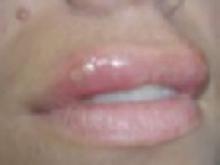There are 3: valacyclovir, acyclovir, and topical penciclovir. Valacyclovir, 2 g twice in 1 day taken during the prodromal stage of herpes labialis, reduces the episode duration and time to healing. Acyclovir, 400 mg, taken 5 times a day for 5 days, decreases the pain duration and healing time to loss of crust (strength of recommendation [SOR]: A, based on randomized controlled trials [RCTs]). Topical penciclovir 1%, acyclovir 5%, or docosanol 10% also decrease the duration of pain and healing time (SOR: A, based on RCTs).
The best prophylaxis for herpes labialis is oral valacyclovir 500 mg daily; it reduces the frequency and severity of attacks (SOR: B, based on RCT). Sunscreen may be effective in sunlight-induced recurrence (SOR: B, based on 2 small crossover RCTs).
Let patients self-treat before breakouts
Tricia C. Elliott, MD, FAAFP
Kelsey-Seybold Family Medicine Residency Program, Houston, Texas
An effective management for the treatment of recurrent herpes labialis at the prodromal stage is a patient-initiated, self-treatment approach. In my experience, providing these patients with a prescription for valacyclovir prior to breakouts results in better overall outcomes. Patients are able to start self-treatment at the earliest signs of symptoms and feel more in control of their disease. With the lower pill burden and shorter treatment duration of valacyclovir, many patients report significantly shorter healing times, reduction in duration of pain, better compliance, and overall satisfaction.
This approach is particularly useful for patients like medical personnel and daycare workers, for whom outbreaks can pose significant adverse outcomes, such as loss of work days and increased risk of infecting others. If breakouts are frequent and risk of infecting others is high, consider daily valacyclovir as prophylaxis for these patients.
Evidence summary
Herpes labialis is the most common presentation of herpes simplex virus 1 (HSV-1) infection and generally represents reactivation. The disease progresses quickly; therefore, early treatment is required.
Patient-initiated treatment can be effective. TABLE 1 shows the comparison of oral (valacyclovir and acyclovir) and topical (penciclovir, acyclovir, and docosanol) antiviral agents for treatment of herpes labialis.1-5
TABLE 1
Antiviral agents for herpes labialis: A comparison
| DRUG | REGIMEN (OR PLACEBO) | N | OUTCOME (VS PLACEBO) | ||
|---|---|---|---|---|---|
| HEALING TIME | PAIN DURATION | ||||
| Oral | Valacyclovir* | 2 g twice daily for 1 day | 603 | 1.3 days ↓ (95% CI, –1.9 to –0.7) (4.8 vs 6.1 days)1 | |
| 615 | 1.3 days ↓ (95% CI, –1.8 to –0.7) (5.1 vs 6.4 days)1 | ||||
| Acyclovir | 400 mg 5 times a day for 5 days | 174 | 1.3 days ↓ (2.5 vs 3.8 days)2 | ||
| Topical | Penciclovir* 1% | Every 2 hours during waking hours for 4 days | 3057 | 31% ↓ (HR=1.31; 95% CI, 1.20–1.42)3 | 28% ↓ (HR=1.28; 95% CI, 1.17–1.39)3 |
| 1573 | 0.7 days ↓ (4.8 vs 5.5)3 | 0.6 days ↓ (3.5 vs 4.1)3 | |||
| Acyclovir 5% | 5 times a day for 4 days | 689 | 0.5 days ↓ (4.3 vs 4.8) (HR=1.23; 95% CI, 1.06–1.44)4 | 0.3 days ↓ (2.9 vs 3.2 days, HR=1.20; 95% CI, 1.03–1.40)4 | |
| Docosanol* 10% (available OTC) | 5 times daily | 737 | 0.7 days ↓ (95% CI, 0.08–0.92 days) (4.1 vs 4.8 days)5 | 0.56 days ↓ (95% CI, 0.125–0.69 days) (2.18 vs 2.74 days)5 | |
| * FDA approved | |||||
| CI, confidence interval; ↓, decrease; HR, hazard ratio. | |||||
Oral treatments: Shortening episodes by a day
Two RCTs have shown that valacyclovir (the prodrug of acyclovir, which has 3 to 5 times greater bioavailability) at a dosage of 2 g twice in 1 day significantly decreased the episode duration and time to lesion healing compared with placebo. In the first study (n=603), the mean episode duration was decreased by 1.1 days (5.0 vs 6.1 days; 95% confidence interval [CI], –1.6 to –0.6); in the second study (n=615) by 1.0 day (5.3 vs 6.3 days; 95% CI, –1.0 to –0.5).1
Oral acyclovir has also been shown to be effective in a well-done RCT (TABLE 1). For a subgroup of patients who started acyclovir in the prodrome or erythema stage, the duration decreased (2.5 vs 3.9 days, P=.02), but in the papular stage, it did not decrease significantly (2.5 vs. 3.6 days, P=.36).2


